
Inspecting an outcropping of granite pegmatite
near the site. Photo by Chuck Hixson.
Click images to enlarge
|
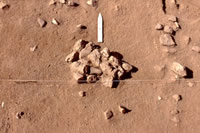
One of many hearths at the rancheria, likely
used for cooking. Photo by Chuck Hixson.
|
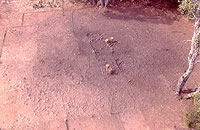
Burned rock midden at the site. Photo by
Chuck Hixson.
|
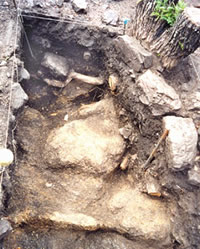
Central pit in midden, with large rocks
lining interior. Photo by Gene Schaffner.
|
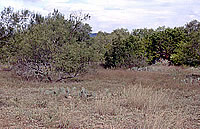
Prickly pear cactus grows abundantly in
the site area, to the dismay of investigators working there.
Photo by Chuck Hixson.
|
|
The people who lived at the Graham-Applegate
rancheria were great consumers of granite rock; they brought
many tons of it into the settlement from isolated outcrops
in the surrounding area. Some of the rocks went into the construction
of the houses, providing material for the wall supports and
central hearths, but by far the greatest amount of rock was
used in the cooking of food. Most rocks when heated in a fire
absorb and store heat. Long after the fire has died down,
the rocks continue to release the heat, making them ideal
heating elements for different kinds of stone-age cooking
"appliances." In prehistoric times, the people of
central Texas made full use of this kind of cooking technology,
constructing stone hearths in many different shapes and sizes.
Most interestingly, they constructed earth ovens—layered
arrangements of hot rocks and food placed in shallow pits
and capped by a thick layer of earth. These were used to cook
many kinds of foods but particularly certain plant foods that
require long cooking before they are edible or their full
nutritional value is realized. When the rocks cracked into
small pieces from repeated heatings, they were tossed out
and the oven pits re-lined with new rocks. The huge mounds
of fire-cracked rocks, or burned rock "middens,"
that built up over time around these often inconspicuous ovens
have long confounded archeologists.
Virtually all the cooking features—hearths and
ovens—that have been studied in central Texas were constructed
of limestone rocks. The Edwards Plateau that dominates the region
is made up of Cretaceous limestone and was the only rock available
in most places. However, this is not the case at the Graham-Applegate
site. Millions of years ago, erosion removed a portion of the Cretaceous
limestone on the northeastern part of the Plateau, exposing a 2500-square-mile
region of ancient metamorphic and igneous rock known today as the
Llano Uplift. The Graham-Applegate rancheria is located in the southeastern
part of the Llano Uplift in an area of granite bedrock. In the immediate
area of the site, the granite near the surface has weathered into
small gravel-size fragments, except for thin horizontal seams (known
as pegmatites) of more consolidated feldspar and quartz rock. Along
the nearby arroyos where the pegmatite seams are exposed, ancient
people could have gathered rocks large enough for their building
and cooking purposes.
The rancheria people constructed dozens of small,
flat circular hearths on which they grilled or roasted different
kinds of foods. Unfortunately, with the exception of mussel shells,
few food remains have survived in the sandy, gravelly soils at the
site. Scores of these shells have been found scattered about the
area, particularly around the small hearths on which they were cooked.
Mussels were probably collected from the Llano River a half-mile
(0.8 km) away. Considering the large numbers of arrow points found
at Graham-Applegate, animal foods must have been very important
but the direct evidence is no longer there: even bones do not last
long in the ground in the site area.
The single largest feature at the rancheria is the
earth oven and its surrounding pile of fire-cracked rock (burned
rock midden) that dominates the southwestern corner of the site.
While burned rock middens of limestone rock are common on the Plateau,
very few granite middens have been recorded by archeologists in
the Llano Uplift. Why this is so is not yet clear; perhaps earth
ovens were only rarely constructed of granite because they made
inferior heating elements, although recent experiments do not seem
to bear this out. Granite takes and holds heat well but breaks apart
after only one or two uses. Limestone, in contrast, can sometimes
be reheated five or more times before breaking. Perhaps granitic
burned rock middens are more difficult to detect on the Llano Uplift
because of the soil and topographic conditions there.
The midden at Graham-Applegate went unnoticed until
a test pit was excavated over it. Almost 30 feet across and nearly
2 feet thick, the burned rock midden at the Graham-Applegate rancheria
contains perhaps as much as 20 tons of burned rock, representing
many oven firings and subsequent cleanings. Few food remains were
found in the burned rock debris surrounding the oven; there were
a few small fragments of a large, deer-sized animal, mussel shells
both large and small, and a small amount of charred plant material.
The central area of the midden contains traces of numerous pits
dug out over time for ovens. These pits were probably lined with
large granite boulders. The soil in the interior is almost black
from the many fires that burned there. Outside the midden area the
soil is a light tan but, closer to the center, it becomes more and
more stained by carbon. Evidence from other sites indicates these
ovens were constructed to bake certain plant foods for long periods
of time. Just what was cooked at the rancheria is not yet known,
although we have some ideas. Sotol, an important food that was baked
by aboriginal people in earth ovens, does not grow in large numbers
(if at all) in the sandy soils of the Llano Uplift. A related species,
a kind of narrow-leaf yucca, however, does; the edible parts include
the emerging flower stalk available in late spring and the green
seed pods that develop a little later in the year. Both yucca and
sotol could be baked in earth ovens.
Today, the site is covered by dense stands of
prickly pear cactus, much to the consternation of the crew—especially
those who don't watch their step. Ranching in recent times
has no doubt encouraged its spread but this plant was certainly
present in the Llano Uplift in the Late Prehistoric. The green,
pad-like stems, or nopales, were a reliable food source as
were the fruit or tunas when ripe in late summer. If the rancheria
was occupied primarily in winter, nopales would have been
available for earth-oven baking; if the stay was extended
into spring, wild onions and yucca stems would have been an
abundant food source for the rancheria dwellers.
|
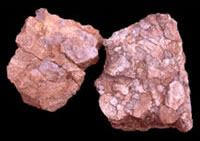
Granite rock from the Llano Uplift area,
such as that used by the rancheria people for constructing
earth ovens and small fires. Photo by Chuck Hixson.
|
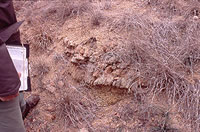
Exposure of granite pegmatite, where rancheria
folk likely gathered stones for use at their village. Photo
by Chuck Hixson.
|
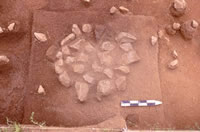
Hearth used by later Austin phase visitors
to the site. Photo by Chuck Hixson.
|
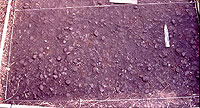
Close-up view of midden and its dense accumulation
of fire-cracked rock. Photo by Chuck Hixson.
|

Soil samples from midden area, showing
light-colored, unstained soil from outside midden (left) and
darker, increasingly carbon-stained samples taken from within
midden and central pit. Photo by Gene Schaffner.
|
|